5 Top Tips On Training Your Cannabis Plants
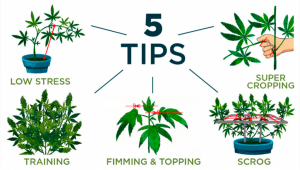
- 1. Most common training techniques for cannabis plants
- 1. a. Topping / pinching
- 1. b. L.s.t / tying down
- 1. c. Super cropping
- 1. d. Fimming
- 1. e. Pruning
- 1. f. Defoliation
- 1. g. Scrog
- 1. h. Mainlining
- 2. Pick the best suited strains
- 3. Decide on a vegetative period for non-autoflowering cultivars
- 4. What about training autoflowering cultivars?
- 5. Rest and recovery
- 6. Limited grow space
- 7. Training indica cannabis plants
- 8. The top 3 fast buds strains recommended for plant training
- 9. In conclusion
When growing Cannabis plants, there are many tricks and techniques that can seriously influence the growth structure, final plant height, and overall enhancing production. So if you want to get into cannabis training and get to know the best growing techniques for cannabis, here are Fast Buds' 5 top tips to consider when growing your plants in the vegetative stage of 18/6 and what to know for next time growing autoflowers or feminized seeds.
Before discovering some of the best training tips around, it helps to know exactly why you should conduct cannabis training in the first place. If you’ve never grown weed before, the idea of training a plant might seem odd. However, it very often produces superior results than leaving your specimen to do its own thing. Training techniques differ in their approach. Some are more gentle and simply involve manipulating the growing direction of branches, whereas others require growers to physically damage plant tissue. So, why should you train a cannabis plant? There are many benefits to be had. Training improves the shape and structure of plants, improves aeration and decreases the risk of mold, and improves yields. Now that you have the low down on cannabis training, it’s time to discover five of the best methods.
1. Most Common Training Techniques For Cannabis Plants
Topping / Pinching
Refers to the removal of the crown tip, exposing the axillary shoots. This will cause the plant to focus on growing 2 main crown shoots. A very easy technique that should be performed with a clean, sterile pair of scissors or scalpel. Just remember that you should know how to top a cannabis plant before trying it to avoid stressing your plant too much. Topping results in the plant’s possible height decreasing, with the one top cola being effectively split into two budding sites which helps the canopy spread and become more evenly spaced. When you top a cannabis plant, the main hormone that is responsible for the upward growth of the main stem is “switched off”, with a different hormone that promotes lateral growth taking the main stage. The first top should be executed only after the plant was from 5 to 6 nodes. This is very important as plants with less development than this can die from the shock that topping produces.
To top the plant, use your sterilized cutting tool and cut the main stem just above the 4th node, making sure that you do not damage the two baby branches that are just starting to emerge on either side of the node. These branches will become the two main colas. You can repeat this process as many times as you like, and the more times you top the plant, the more main colas you will end up with. These will not be as big as the original cola would have been, but you will end up with a more evenly spread canopy and a larger yield in the end. Keep in mind that the plant will need 7 to 11 days to fully recover, so you will have to extend the vegetative growth stage to compensate. This method is only for photoperiod plants.
Topping and pinching seem brutal, especially to beginner growers. However, the benefits of this technique far outweigh how it looks. Ultimately, there are two primary benefits to this approach. Firstly, it helps to create a more even canopy. Instead of sending one direct cola upwards, topping creates a divergence in the main stem, which results in a more balanced structure. Preventing the main cola from forming also has an advantage, as these huge buds can fall prey to mold under the wrong conditions. Topping helps to create more uniform flowers that are less likely to foster fungal pathogens. Secondly, topping is a form of size management and is particularly effective for large strains when you're trying to grow in a stealthy fashion. Preventing surging vertical growth and transforming it into lateral branching creates smaller plants that are better suited for guerilla growing and indoor cultivation in limited space.
L.S.T / Tying Down
It's the art of lowering certain points of the canopy, in order to create a uniform, multi-tipped canopy and to expose light to the inner parts of the plants. There are different ways to tie side branches down and using twine, metal wire, and even weights in some cases proves the most effective. This can be done with an untopped plant, where you carefully bend the main cola down so the other budding sites have a better chance at competing with it.

This is one of the very few training methods we recommend trying with autoflowering strains. This training method works great with topping, as it helps keep the canopy at one uniform height, which in turn means that all the bud sites will receive a similar amount of light penetration and grow to a similar size and density.
Super cropping
Is the process of purposely breaking the inner cell walls of a Cannabis plant, by using the pressure applied from finger and thumb. This technique is classed as high stress and should only be performed by more experienced growers. When super cropping, you have to take real care to only apply enough pressure to break the inner cells and not snap the branch or stem entirely. A good indication that the cell walls have been damaged to the degree we are looking for is a “popping” feeling, which is sometimes even accompanied by a soft pooping sound (but not always).
Super cropping can be performed in the last 7 to 10 days of the vegetative growth period before flipping the lights to flower. This gives the plants enough time to recover before they go into the crucial flowering growth period. If you have some experience with cultivation and super cropping in particular, then you can go ahead and super crop your plants again about 2 weeks into the flowering stage. Cannabis plants usually display a final boost of growth at this time before they totally settle into flowering, and by super cropping, at this time you can boost your chances of bumping up the final yield. Super cropping can boost the overall strength of a plant and can provide extra support to the branches for the heavy, dense buds that should follow. This is an advanced method and so we do not recommend this one for novice growers. This method is for photoperiod plants only, not autoflowering cultivars.
Fimming
Describes when 70-80% of the growth tip is cleanly removed and cut away using scissors. As the top growth is temporarily reduced, the remaining energy will go to the growth sites beneath the highest point. The term “fimming” is actually an abbreviation for “fuck, I missed!” and was born from growers accidentally topping the plant incorrectly. It works on a similar principle to topping, and they can be used pretty much interchangeably. In general though, we suggest to top plants instead of dimming. This method is for photoperiod strains only.
Pruning
Or as it is more commonly known in the cannabis world - lollipopping, involves removing selected foliage, with the understanding that what remains will go to the rest of the plant. This is advantageous for eliminating lower, popcorn buds, improving aeration around the base of the plants, and focusing on a top-heavy canopy.
By removing the lower branches that do not produce the quality of flower that we are looking for, the plant can effectively redirect the energy that would have been spent to the sites where the best buds are produced. With your sterilized cutting tool (scissors, scalpel, shears) work your way up from the base of the pot and remove the lower branches as you see fit. Never remove more than 60% of the growth, otherwise there is a high chance the plant could wither away and die. This method is not suitable for autoflowering strains.
Defoliation
Is the term used to describe removing the larger fan leaves on a weed plant. This, in theory, allows for the redistribution of energy to the bud sites, but it should only be performed on healthy, thriving plants with what looks like an excess of fan leaf coverage. This also allows for better light penetration to the lower branches, which will help those lower quality buds to develop into fat, juicy nugs. It can also drastically increase airflow and air exchange through the canopy, which helps in combating pest, mold, and fungal issues.
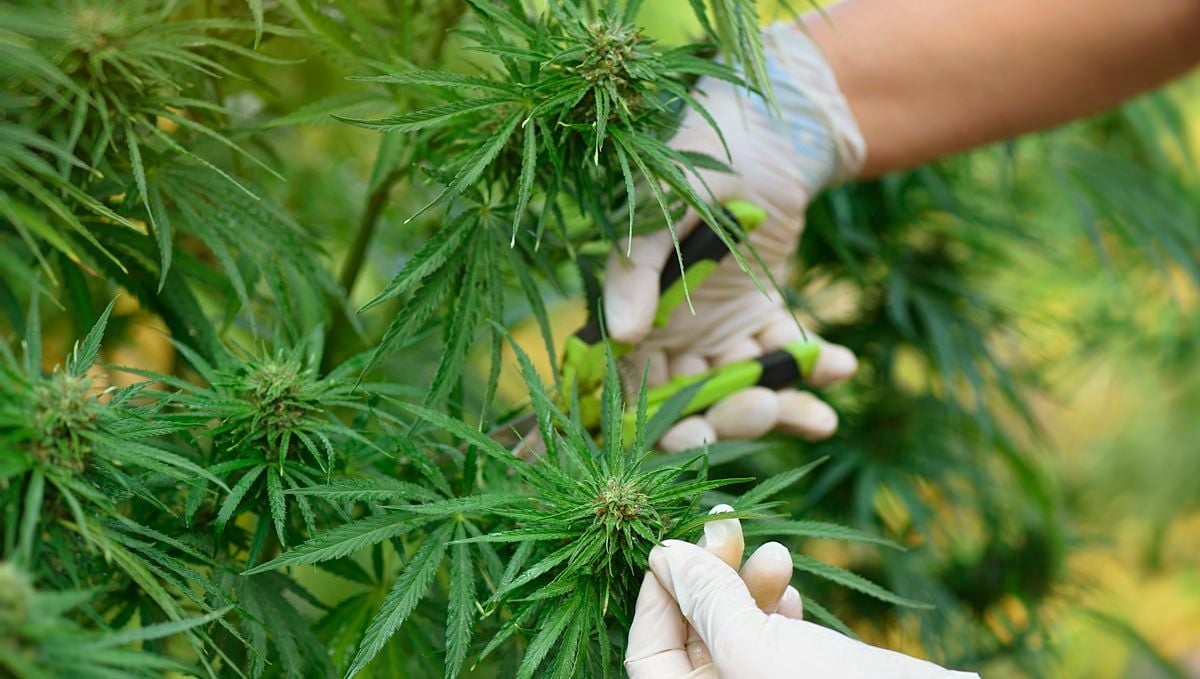
Never take more than about 25% of the fan leaves at one time, and give the plant 7 to 12 days to recover before taking any more fan leaves away. There is an extreme form of defoliation known as “Schwazzing”, and while some growers swear by this method we feel that it is too aggressive and unnecessary. While you can defoliate autos to a certain degree, for the most part we recommend leaving your autos be.
SCROG
Refers to when a screen is applied to a grow room, to multiple or one huge plants, to be trained and manipulated through the screen. This is usually a long-winded process that can take from 6 weeks upwards to perfect. The screen acts as a barrier to growth height, which helps you keep the canopy all at one specified level (similar to the tie-down procedure, but more effective). While this method can work wonders, it does require a slightly longer vegetative growth period than some of the other methods.
There are a bunch of materials you can use to make a screen, but the easiest (in our opinion) is to make a simple frame out of wood and lay some chicken wire over it, then tack it in with some small nails. You can also use a fishing net, thin bamboo poles, or really anything that acts as a screen and will hold the branches in place. This method is perfect for people living in states or countries where you are only able to grow a small number of plants. When combined with topping and over an extended vegetative growth stage, the possible number of high-grade bud sites is almost never-ending.
Mainlining
One of the newer, more advanced training techniques currently used by hobby and commercial growers. This method is a bit of a Frankenstein, as it is achieved by combining multiple other training methods into one protocol, namely LST, topping, and a ScrOG net. That may make it sound complicated and hard to achieve for novice growers, but in truth, it requires only a little bit of knowledge and effort. And, once you know how to do it, you can increase that one central cola to 2, then 4, then 8… why not 16 or 32, 64, 112? You get the idea. The only tools required for this method are soft plant ties and a cutting implement that has been sterilized. The process begins in the same way as topping (see above), but with mainlining your top at the 3rd node. You also need to lollipop (again, see above) up to the 3rd node.
Once the new branches start to grow into the classic topped “Y” shape, it’s time to tie them down to create a symmetrical shape. You want to tie the growth down to run in parallel with the floor. This is called the “manifold”. Once each new main branch has four pairs of leaves fully grown, it’s time to top them at the third node just like you did with the main stem. But unlike the manifold, you are not going to lollipop all of the growth, just the growth at the second node. If you have done this to both branches, you should have 8 main bud sites that should receive similar quantities of nutrients. Male sure to tie all the branches down to the same level, or alternatively, you can add a SCROG screen to help with canopy level uniformity. Obviously, this technique is too aggressive for autoflowering plants.
2. Pick The Best Suited Strains
As a grower becomes more familiar with Cannabis genetics and can differentiate between the basics of indica, sativa and hybrid cultivars, he will realize which type of plant is better suited for plant training.
When it comes to plant training, this basically means the hands-on practice of manipulating the canopy to your will. It is important to have a set goal in terms of growing time, and knowing which strain and techniques will work best for your skill and experience level.
Many seed banks and breeders will explain in the strain description if in fact that strain is ideal for a uniform Sea of Green set up, or better as SCROG. For example, Sativa dominant autoflowering cultivars such as Original Auto Sour Diesel and Original Auto Jack Herer would be the best candidates for plant training, in comparison to Indica-dominant hybrids that remain shorter and more stocky in appearance.
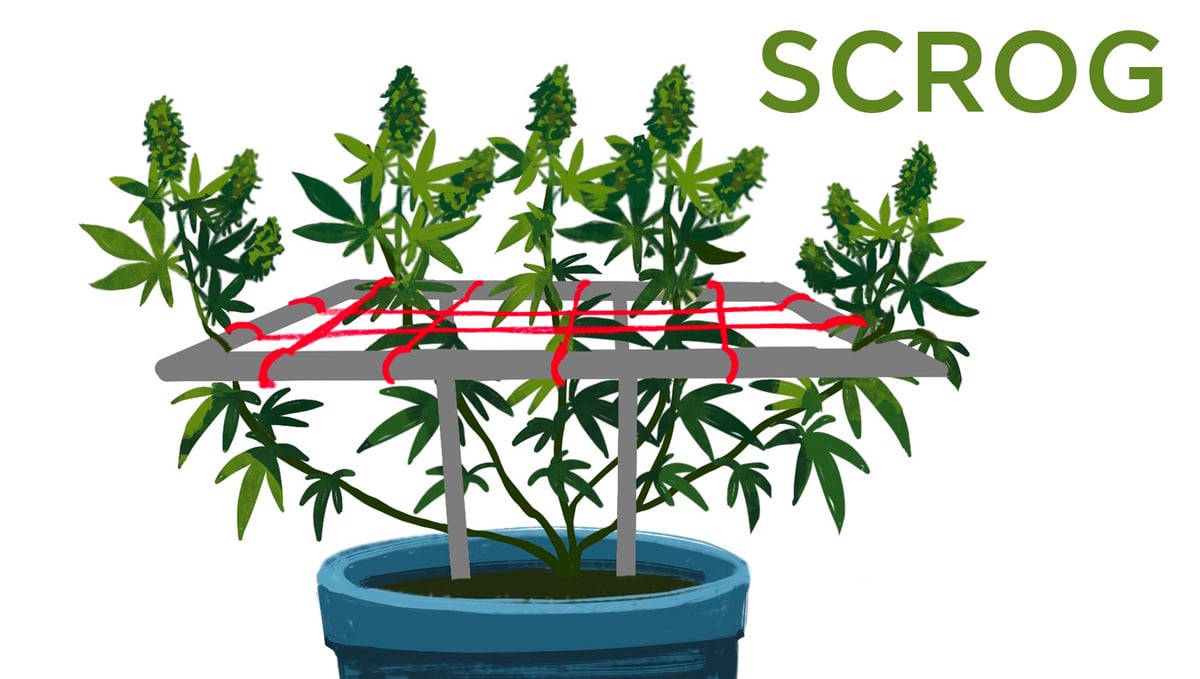
3. Decide On A Vegetative Period For Non-Autoflowering Cultivars
The vegetative stage refers to the amount of time your Cannabis seedling or clone, spends under a light cycle of 18/6. This is the point where your plants will focus on producing as much foliage as possible. Depending on which specific strain you are growing out, the pot size, plant count, your skill and experience, and the size of your growing space will all determine what is really possible.
Grow Phases of 7-14 days
The standard model for when growing for commercial production in both organic and hydroponics methods. The main goal behind a short growing time is to create a fast turnaround of many small-sized flowering plants, whilst reducing electricity bills also and dramatically cutting down on the amount of nutrient solution required. There is no need for training seedlings during this short time frame.
Grow Period of 21-28 days
During this time you are able to top the plants, prune and even apply gentle super cropping and breaking of the stems. Sativa and hybrid strain will offer more in comparison to stocky and stubborn Indicas. It is important to allow your plants full rest and recovery, so perhaps a topping up to two times, with one FIM is perfect, without demanding too much from the plant so early on.
-
Top Plants 1-2 times
-
FIM plants once
-
Prune one week prior to flowering
-
Apply super cropping
-
L.S.T
Grow Period of 36-70 days
There are advantages and disadvantages to growing one huge plant that requires up to ten weeks of vegetative time. Apart from incurring high electricity bills, the use of nutrients and demanding hands-on maintenance on a regular basis, the grower gets to really push their plant to the limit in terms of size and production.
-
Top Plants 3-6 times
-
FIM plants multiple times
-
L.S.T
-
Use of screen (SCROG)
-
Super cropped multiple times
-
Pruned one week prior to flowering
4. What About Training Autoflowering Cultivars?
Due to autoflowering Cannabis being non-dependant on a darkness period of 12 hours like photoperiod strains do, we recommend that the only training to perform is an L.S.T to allow more light to enter the canopy, as well as creating more top-heavy colas. Pruning is always a good idea with any type of Cannabis plant as that will divert the growth energy to the upper parts most dependent on flowering.
We DO NOT recommend topping or fimming your autoflowering plants, as this may stunt the growth and interfere with the growth structure of the canopy.
5. Rest And Recovery
Low stress training (L.S.T.) not only means tying the plant down but it basically covers any technique that does not purposely cause the plants heavy stress or trauma. Hands-on methods such as topping plants, fimming, and gently tying down with string or metal wire all fall under the category of low stress.
On the other hand, high stress techniques involve purposely breaking the inner cell walls of the plants. The end result is a rush of repair growth hormone sent from the roots of the Cannabis plants up towards the break. Within a short time frame, the original broken stem will now grow with a hard, wooden knuckle meaning the plants will grow stronger with an increase in vigor and structure.
6. Limited Grow Space
Our top tip is to work with indica strains and top the plants early on in the first few weeks. By exposing the axillary shoots, the growth structure of the plant will become bushier and will grow two main crown shoots, and prevent the plants from producing the growth hormone Auxin that causes apical dominance.
Fimming is also an excellent way to dramatically slow down vertical growth and allow the lower growth sites to receive more growth energy. By carefully removing 70-80% of the growth tip, this will buy you between 5-7 days before the top growth sites grow back to normal. By this stage, there will be a clear difference in the plants, and they will have obtained a bushy and dense appearance.
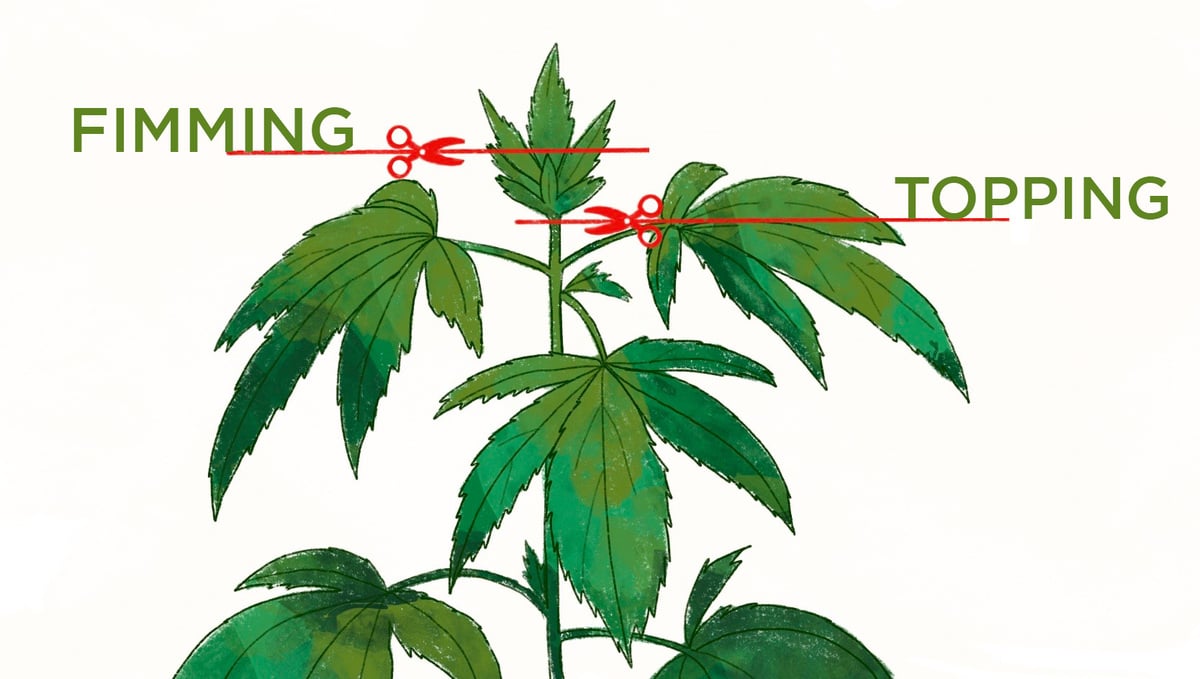
7. Training Indica Cannabis Plants
Due to their genetic makeup, Indica dominant cultivars are well known for remaining low during the growing period, with short internodal spacing, thick fingered fan leaves, and a stout growth structure. Oftentimes, these varieties can be the most difficult to work with in terms of what training can be applied and can grow extremely bushy in no time, leaving the beginner growers overwhelmed once the flowering period commences.
- Pruning lower fan leaves that block lower grow shoots is a great way to expose intense lighting to the underparts, as well as improve airflow and reduce the risk of insects.
- Topping is an excellent way to create multiple crown shoots, however, be careful not to overcrowd your canopy with Indicas, unless intense pruning is performed prior to flowering.
- Indica Cannabis plants will grow with uniform and homogeneous characteristics, making them perfectly suited for a Sea of Green set up, involving the plants being grown in small pots, with a very short vegetative time and packed closely together.
8. The Top 3 Fast Buds Strains Recommended For Plant Training
Here is a helping hand to get you on your way to the biggest harvests possible, with our best strains for applying plant training:
A sativa dominant hybrid that loves to be trained, in order to really get the most out of this large yielding strain. An excellent way to control her final height also.
One of the most potent strains out, as well as one of the most productive. A solid performer that grows one main cola and thick cactus-like branches.
Zkittlez Auto has a very large number of long side branches that may need support. Excellent results when tying down and pruning.
9. In Conclusion
Executing the right techniques at the right times will allow you to not only increase yields and control the canopy but also teach you to be more hands-on with your Cannabis plants. Learning how durable and resistant to training your plants are is one way to get familiar with certain cultivars, and having patience is very important allowing the plants to fully heal and recover. Remember that your plant may have different reactions to the different training techniques so make sure you know how to Scrog or how to top a marijuana planta before starting to avoid ruining your harvest.
Good luck training those monster plants!








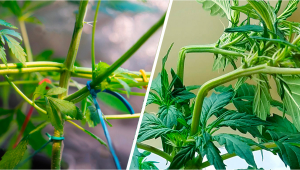
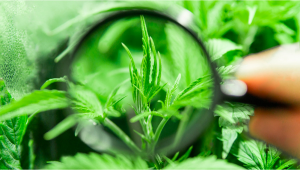
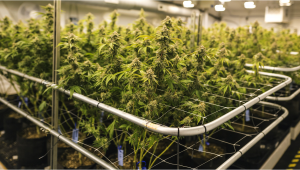
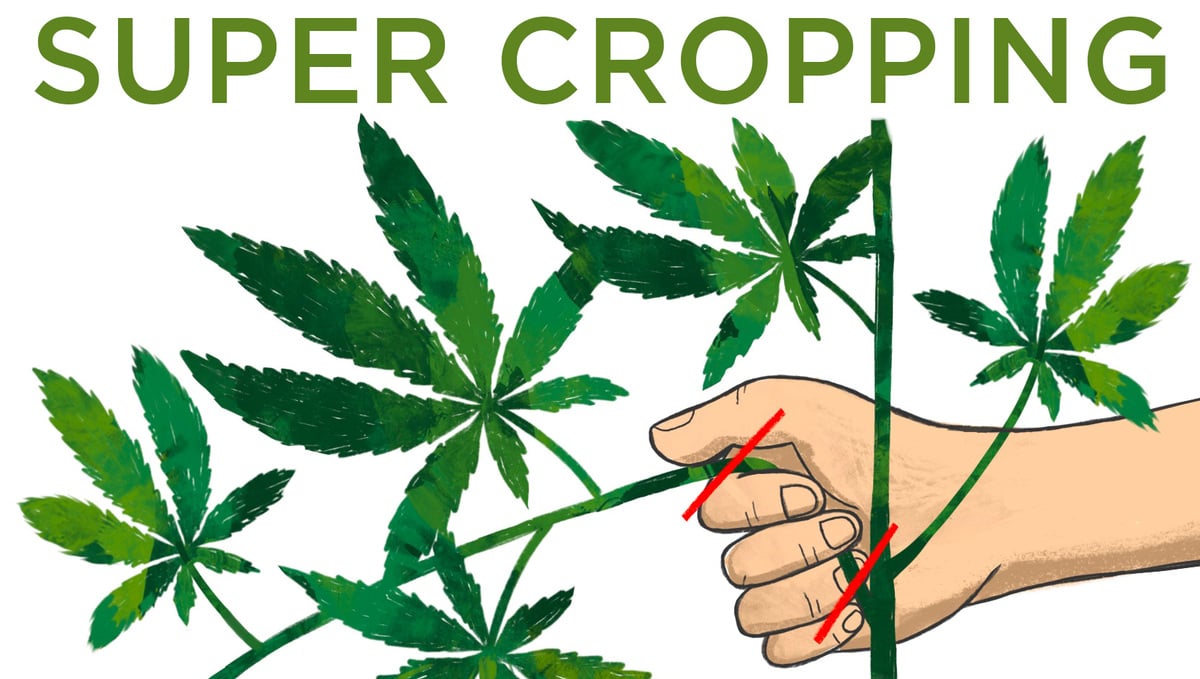
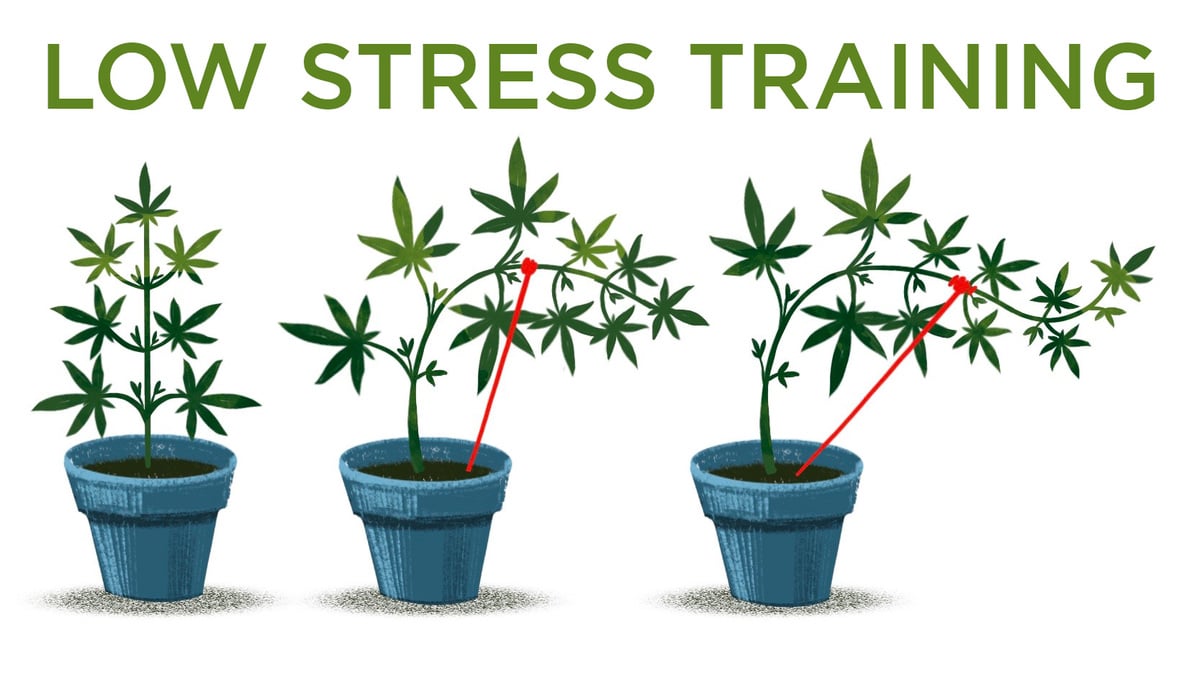


Comments